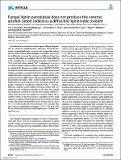Por favor, use este identificador para citar o enlazar a este item:
http://hdl.handle.net/10261/163821COMPARTIR / EXPORTAR:
 SHARE SHARE
 CORE
BASE CORE
BASE
|
|
| Visualizar otros formatos: MARC | Dublin Core | RDF | ORE | MODS | METS | DIDL | DATACITE | |

| Título: | Fungal lignin peroxidase does not produce the veratryl alcohol cation radical as a diffusible ligninolytic oxidant |
Autor: | Houtman, Carl J.; Maligaspe, Eranda; Hunt, Christopher G.; Fernández-Fueyo, Elena CSIC ORCID; Martínez, Ángel T. CSIC ORCID ; Hammel, Kenneth E. | Palabras clave: | Phanerochaete chrysosporium Biodegradation Computer modeling Confocal microscopy Free radicals Imaging Lignin degradation Peroxidase White rot fungus |
Fecha de publicación: | 30-mar-2018 | Editor: | American Society for Biochemistry and Molecular Biology | Citación: | J Biol Chem 293(13):4702-4712 (2018) | Resumen: | Peroxidases are considered essential agents of lignin degradation by white-rot basidiomycetes. However, low-molecular-weight oxidants likely have a primary role in lignin breakdown because many of these fungi delignify wood before its porosity has sufficiently increased for enzymes to infiltrate. It has been proposed that lignin peroxidases (LPs, EC 1.11.1.14) fulfill this role by oxidizing the secreted fungal metabolite veratryl alcohol (VA) to its aryl cation radical (VA+•), releasing it to act as a one-electron lignin oxidant within woody plant cell walls. Here, we attached the fluorescent oxidant sensor BODIPY 581/591 throughout beads with a nominal porosity of 6 kDa and assessed whether peroxidase-generated aryl cation radical systems could oxidize the beads. As positive control, we used the 1,2,4,5-tetramethoxybenzene (TMB) cation radical, generated from TMB by horseradish peroxidase. This control oxidized the beads to depths that increased with the amount of oxidant supplied, ultimately resulting in completely oxidized beads. A reaction-diffusion computer model yielded oxidation profiles that were within the 95% confidence intervals for the data. By contrast, bead oxidation caused by VA and the LPA isozyme of Phanerochaete chrysosporium was confined to a shallow shell of LP-accessible volume at the bead surface, regardless of how much oxidant was supplied. This finding contrasted with the modeling results, which showed that if the LP/VA system were to release VA+•, it would oxidize the bead interiors. We conclude that LPA releases insignificant quantities of VA+• and that a different mechanism produces small ligninolytic oxidants during white rot. | Descripción: | 11p.-5 fig.-1 tab. + 13 p.- Supporting Information | Versión del editor: | http://dx.doi.org/10.1074/jbc.RA117.001153 | URI: | http://hdl.handle.net/10261/163821 | DOI: | 10.1074/jbc.RA117.001153 | ISSN: | 0021-9258 | E-ISSN: | 1083-351X |
| Aparece en las colecciones: | (CIB) Artículos |
Ficheros en este ítem:
| Fichero | Descripción | Tamaño | Formato | |
|---|---|---|---|---|
| J. Biol. Chem.-2018-Houtman-4702-12.pdf | Artículo principal + material suplementario | 6,41 MB | Adobe PDF |  Visualizar/Abrir |
CORE Recommender
PubMed Central
Citations
7
checked on 19-abr-2024
SCOPUSTM
Citations
23
checked on 23-abr-2024
WEB OF SCIENCETM
Citations
20
checked on 29-feb-2024
Page view(s)
291
checked on 23-abr-2024
Download(s)
255
checked on 23-abr-2024
Google ScholarTM
Check
Altmetric
Altmetric
Artículos relacionados:
NOTA: Los ítems de Digital.CSIC están protegidos por copyright, con todos los derechos reservados, a menos que se indique lo contrario.
